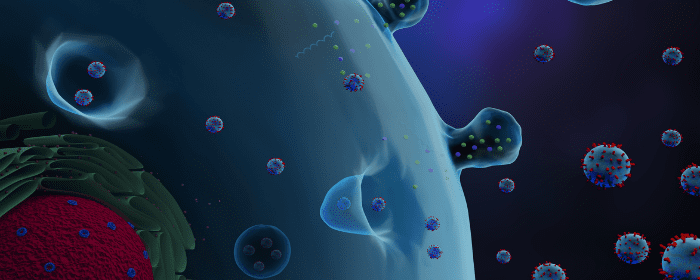
by admin | Dec 6, 2022 | Mesenchymal Stem Cells, Stem Cell Research, Stem Cell Therapy
Mesenchymal stem cells (MSCs) have been widely used in a number of applications designed to aid in the regeneration and healing of human tissue. Prized for their multipotent capacity to differentiate into a variety of other specific cell types, MSCs have consistently demonstrated the ability to seek out damaged tissue while also reducing inflammation and promoting healing.
Recently, the discovery of a specific type of MSC known as circulating mesenchymal stem cells has demonstrated increased potential for the use of MSCs in the regeneration, repair, and engineering of tissue throughout the body.
Circulating MSCs demonstrate characteristics similar to MSCs that are derived from bone marrow and are typically found in very low concentrations in healthy individuals. While these specific MSCs have demonstrated the ability to migrate to the site of damaged or injured tissue like other MSCs, what makes circulating MSCs so interesting to researchers is their distinct genetic profile – especially when compared to bone marrow-derived stem cells (BM-MSCs).
Xu and Li’s review provides a summary of the basic knowledge of circulating MSCs, their potential clinical applications, and the issues of using allogeneic MSCs for clinical therapy.
While these circulating MSCs, also known as peripheral blood-derived MSCs (PB-MSCs), have great potential in the field of tissue engineering and regeneration, they are found in very low quantities within the human body. As a point of reference, Xu and Li point out that the frequency of BM-MSCs in humans under normal conditions is very low and ranges from 1 in 104 to 1 in 105. Compared to BM-MSCs, the concentration of circulating MSCs is even lower, typically around 1 in 108.
Despite their low numbers, researchers have successfully identified and collected PB-MSCs in both animal and human models. In both scenarios, PB-MSCs demonstrated characteristics of cell proliferation and multi-differentiation potential that are similar to those observed in BM-MSCs. In addition, and adding to their potential, PB-MSCs are plastic-adherent, have multi-differentiation potential, and demonstrate the ability to differentiate into a variety of cells.
Adding to the benefits described above, and unlike stem cells harvested from embryonic sources, PB-MSCs are not attached to ethical concerns. In addition, numerous research studies have demonstrated the use of MSCs in a variety of applications, including cardiovascular, bone, and cartilage repair have resulted in general significant improvements in tissue healing and regeneration.
To date, studies specific to circulating MSCs are rare. However, Xu and Li highlight that circulating MSCs, while originally found in the bone marrow and other sources throughout the body, are a special subset of MSCs found in circulation. While additional study is required, early research seems to indicate that the release of these circulating MSCs is tightly controlled by a variety of systematic and local factors, including inflammatory cytokines, hormones, and a variety of growth factors.
There is increasing evidence that indicates MSCs are immunosuppressive cells and that allogeneic MSCs may be used with similar therapeutic efficacy to autologous MSCs. Considering this, Xu and Li conclude that allogeneic transplantation seems to be more promising and a way to ensure that patients can receive treatment at the best time and without significant fear of rejection.
As research continues to explore the potential benefits and drawbacks of circulation MSCs, the authors point out that a lack of standard procedures for therapeutic MSC administration remains a critical issue for the clinical application of MSCs. These critical issues need to be addressed through carefully designed animal and clinical trials before clinical applications of MSCs can be used in patients with certain diseases.
Source: “Circulating mesenchymal stem cells and their clinical implications.” https://www.sciencedirect.com/science/article/pii/S2214031X1300048X.

by Stemedix | Nov 29, 2022 | COPD
Those afflicted with chronic obstructive pulmonary disease (COPD) struggle with persistent respiratory concerns stemming from airflow blockage and lung inflammation. Here we will discuss regenerative Medicine for COPD.
The conditions that contribute to COPD, such as emphysema and chronic bronchitis, can cause excess mucus production, frequent coughing, wheezing, or shortness of breath.
While treatments including lifestyle changes, medication, therapies, and bronchodilators can slow the disease’s progression and reduce the intensity of its symptoms, there’s no cure for the damage that COPD inflicts on the lungs.
What Is Regenerative Medicine?
While traditional medicine often focuses on alleviating pain and controlling disease and injury symptoms, regenerative medicine, also known as stem cell therapy, focuses on each condition’s root cause.
Regenerative therapies aim to repair and restore damaged or lost tissue, typically by harnessing the body’s natural healing response.
Which Regenerative Medicine Treatments Can Benefit COPD Patients?
COPD causes less air to flow into the airways due to the following changes:
- The lungs’ airways and air sacs lose their elasticity
- The walls of the air sacs in the lungs are destroyed
- Airway walls become thick, irritated, swollen, and inflamed
- Mucus production increases, clogging the airways and reducing airflow
Regenerative treatments are designed to reverse these changes and restore lung health. The most studied and effective regenerative medicine methodologies for COPD are stem cell therapy and exosome therapy.
Stem Cell Treatments for COPD
Stem cell therapy extracts dormant stem cells from bone marrow or adipose tissue and reintroduces those cells into damaged areas that need repair and restoration.
Since stem cells are the body’s only cells capable of differentiating into specialized cells, like brain or lung cells, they offer a versatile option to heal and replace diseased or damaged tissue.
Mesenchymal stem cells (MSCs) have anti-inflammatory and immunomodulation properties that can reduce airway obstruction. At the same time, they work to repair and replace the alveolar epithelial cells, which exchange the gases and air in the lungs. Damaged alveolar cells diminish the resiliency of the lungs’ air sacs and airways.
Exosome Therapy for COPD
Exosomes are tiny, membrane-wrapped sacs released by healthy cells. They share and transfer information with other cells in the body. Early studies show that exosomes derived from stem cells help heal tissue.
In preclinical studies, MSC-derived exosomes reduced inflammation, improved breathing challenges, increased stamina, and enhanced oxygen circulation. Exosome therapy can potentially improve COPD and other pulmonary conditions, including acute respiratory lung distress and post-COVID complications.
Regenerative medicine treatments can open the door to restoring the health of patients with COPD and other lung conditions. As new research continues to show the healing benefits of these treatments, many patients are already experiencing improved health. Contact us today to learn more about Regenerative Medicine for COPD!

by admin | Nov 11, 2022 | Stem Cell Therapy, Diabetes, Mesenchymal Stem Cells, Stem Cell Research
Currently, it’s estimated that nearly 1.5 million Americans are living with type 1 diabetes (T1D), a number that is expected to increase to over 2 million by the year 2040[1]. In the U.S. alone, healthcare costs and lost wages directly related to T1D currently exceed $16 billion per year.
While the most common treatment for T1D continues to be regular injections of insulin and is effective in improving hyperglycemia, the treatment has proven ineffective in removing autoimmunity and regenerating lost islets. Additionally, islet transplantation, a recent and experimental treatment option for T1D, has demonstrated its own set of issues, primarily poor immunosuppression and a limited supply of human islets.
The rapid progression and recent advances in stem cell therapy, including mesenchymal stem cell (MSC) therapy, have created interest in using stem cells to help manage the symptoms of T1D. In this review, Hai Wu reviewed the properties of MSCs and highlighted the progress of using MSCs in the potential treatment of T1D.
Diabetes clinics have demonstrated progress using depleting antibodies as a way to treat T1D, but continue to find remission to typically last for only a short period of time. Additionally, treatment with these antibodies has shown not to discriminate between different types of T cells, meaning even T cells involved in maintaining normal immune function are depleted; this phenomenon has been shown to contribute to other serious health complications.
In addition to the immunomodulatory effects demonstrated by MSCs, they have also shown the ability to recruit and increase the immunosuppressive cells of host immunity. Recent results from clinical trials have shown that just a single treatment with MSCs provided a lasting reversal of autoimmunity and improved glycemic control in subjects with T1D.
While these results demonstrate the potential of MSCs for a wide range of autoimmune diseases, Wu points out that the small sample size of these studies necessitates further clinical trials before considering approval for use in clinical applications.
Studies of human islets and human islet transplantation have been limited because of a shortage of pancreas donors. Although unable to be definitively demonstrated, and considering their ability to differentiate into other cell types, there is a hypothesis that MSCs can transdifferentiate to insulin-producing cells. While not yet fully understood, this hypothesis is further supported by the observation of crosstalk between MSCs and the pancreas in diabetic animals.
Other in vivo studies examining this relationship has produced mixed results. For example, Chen et al. (2004) were unsuccessful in attempts to transdifferentiate MSCs into insulin-producing cells in vitro. On the other hand, several studies, including those by Timper et al. (2006) and Chao et al. (2008) demonstrate the formation of islet-like clusters from in vitro cultured MSCs and the possibility of using MSCs as a source of human islets in vitro.
Despite these promising findings, the author highlights that most of these studies failed to generate sufficient amounts of islets required for human transplantation and long-term stability. However, Wu notes recent advances in tissue engineering, including biocompatible scaffolds, might better support in vitro generation of islets from MSCs.
The author concludes that MSCs can be isolated from multiple tissues, are easily expanded and genetically modified in vitro, and are well-tolerated in both animal and human studies – making them a good candidate for future cell therapy. On the other hand, stem cell therapy alone might not be enough to reverse the autoimmunity of T1D, and co-administration of immunosuppressive drugs may be necessary to prevent autoimmunity.
MSCs have shown great promise in the field of regenerative medicine. While stem cells used as a potential treatment for T1D appear generally safe, the author calls for future in-depth mechanistic studies to overcome the identified scientific and manufacturing hurdles and to better learn how cell therapy can be used to treat – and eventually cure – T1D.
Source: “Mesenchymal stem cell-based therapy for type 1 diabetes – PubMed.” https://pubmed.ncbi.nlm.nih.gov/24641956/.
[1] “Type 1 Diabetes Facts – JDRF.” https://www.jdrf.org/t1d-resources/about/facts/. Accessed 2 Nov. 2022.

by admin | Nov 4, 2022 | Stem Cell Therapy, Mesenchymal Stem Cells, Rheumatoid Arthritis, Stem Cell Research
Mesenchymal stem cells (MSCs) have demonstrated the ability to differentiate into a number of different cells; they also demonstrate immunomodulatory properties that have great potential for use as a stem cell-based therapeutic treatment option and for the treatment of autoimmune diseases – including rheumatoid arthritis (RA).
RA is a chronic and debilitating inflammatory disorder that not only affects the joints, muscles, and tendons, but also damages a number of other body systems, including the eyes, skin, lungs, heart, and blood vessels[1]. It is estimated that roughly 1.5 million Americans are afflicted by RA. While the exact cause of RA is not yet fully understood, the condition is one of over 80 known autoimmune diseases occurring as a result of the immune system mistakenly attacking the body’s own healthy tissue.
Current treatment of RA primarily involves the use of steroids and antirheumatic drugs used primarily to manage associated symptoms of the condition, rather than treat the condition itself. These drugs are also commonly associated with a number of unwanted side effects with users often developing resistance to the medication after prolonged use.
Considering the relative ineffectiveness of drugs designed to treat RA and RA-associated symptoms, scientists have turned to investigate the use of MSC-based therapy as a potential treatment for RA.
As part of this investigation, Sarsenova et al. examined both conventional and modern RA treatment approaches, including MSC-based therapy, by examining the connection between these stem cells and the innate and adaptive immune systems. This review also evaluates recent preclinical and clinical approaches to enhancing the immunoregulatory properties of MSCs.
Through a number of in vitro studies, researchers have realized that MSCs have the ability to inhibit the proliferation of effector memory T cells which, in turn, prevents the proliferation of inflammatory cytokine production. Additionally, these studies have also demonstrated that MSCs are able to modulate functions of the innate immune system by inducting the inflammatory process and activating the adaptive immune system.
Preclinical studies have demonstrated the ability of MSCs to suppress inflammation both through interactions with cells of the immune system and through paracrine mechanisms. This has been demonstrated to be very important as cells of the innate immune system have been shown to have an important role in both the development and progression of RA.
While a number of clinical studies evaluating the effectiveness of MSC-based therapies for the treatment of RA were still ongoing at the time of publication, the nine completed studies primarily demonstrated that using MSCs for the treatment of RA is safe, well tolerated in both the short and long-term, and provides clinical improvements in RA patients.
Despite the many positive and promising outcomes observed through these clinical trials, the authors of this review also point out some limitations associated with the treatment of RA with MSCs. These limitations include many of the referenced studies lacking a placebo control, low enrollment in some studies, and a lack of optimal protocol (for both MSC sourcing and route of administration) for RA treatment with MSCs.
Considering these limitations, Sarsenova et al. point out the need for more well-defined and effective therapeutic windows for the treatment of RA with MSCs, including MSC priming to promote an anti-inflammatory phenotype, in a future study as a way to better understand the perceived benefits of a stem-cell therapy for the treatment of RA and other autoimmune diseases.
Source: “Mesenchymal Stem Cell-Based Therapy for Rheumatoid Arthritis.” 27 Oct. 2021, https://www.ncbi.nlm.nih.gov/pmc/articles/PMC8584240/.
[1] “Rheumatoid arthritis – Symptoms and causes – Mayo Clinic.” 18 May. 2021, https://www.mayoclinic.org/diseases-conditions/rheumatoid-arthritis/symptoms-causes/syc-20353648. Accessed 5 Oct. 2022.

by admin | Oct 1, 2022 | Stem Cell Therapy, Exosomes, Extracellular Vesicles, Mesenchymal Stem Cells, Stem Cell Research
The number of people experiencing autoimmune diseases (ADs) continues to increase worldwide. Currently, it’s estimated that between 2 and 5% of the global population is afflicted with the most severe forms of these diseases, including type 1 diabetes (T1DM), systemic lupus erythematosus (SLE), and rheumatoid arthritis (RA).
An autoimmune disease can occur nearly anywhere in the body and is the result of the immune system mistakenly attacking your body instead of protecting it. While the reason this occurs is not yet fully understood, there are over 100 different types of autoimmune diseases classified into two types: organ-specific (T1DM) and multiple system-involved conditions (SLE and RA).
In addition to T1DM, SLE, and RA, other common autoimmune conditions include Crohn’s disease, ulcerative colitis, psoriasis, inflammatory bowel disease (IBS), and multiple sclerosis (MS).
In addition to not fully understanding why these conditions occur, conventional treatments (mainly in the form of immunosuppressants) alleviate associated symptoms but do not provide lasting or effective therapy for preventing or curing these diseases.
In recent years, mesenchymal stem cells (MSCs) and MSC-derived extracellular vesicles (MSC-EV) have demonstrated immunosuppressive and regenerative effects, and are now being investigated as promising new therapies for the treatment of ADs. In this review, Martinez-Arroyo et al. provide a complete analysis of current MSC and MSC-EV efforts in regard to some of the most severe ADs (T1DM, RA, and SLE) as a way to demonstrate progress in the discovery and application of new stem cell therapies for the treatment of ADs.
Initial research by the International Society of Cellular Therapy in 2006 established that MSCs are able to exert a range of biological functions, with the most well-known being immunosuppressive and regenerative effects, suggesting that MSCs-based therapies for the treatment of ADs is possible. Additional research has also demonstrated MSCs role in regenerative medicine to be safe and effective in treating a wide variety of diseases and injuries.
Further study has demonstrated that MSCs influence immune cell proliferation, differentiation, and function. While this is promising, research also suggested that the microenvironment influences the induction, increase, and maintenance of MSCs immunoregulatory role.
Considering this, the authors of this review suggest that blocking immune cell reprogramming while maintaining MSC roles in the immune microenvironment would provide new insights into identifying strategies for the biological treatment of ADs.
Current research and findings also support the use of MSC for the regeneration of tissue. This same research has also raised concerns related to cell survival, genetic instability, loss of function, and immune-mediated rejection. Because of this, Martinez-Arroyo et al. call for further study to better understand the biology, biomaterials, and tissue engineering used during MSC therapy.
The authors conclude this review by pointing out that there has been a revolutionary change in perspective in the field of MSC-based therapies for the treatment of AD primarily stemming from the use of MSC-EVs as potential therapeutic options.
Additionally, when comparing the use of MSCs to MSC-EVs, the authors highlight several advantages demonstrated by MSC-EVs. These advantages include providing stability and safety, avoiding tumorigenesis, genetic mutability, and immunogenicity when compared to MSCs, and allowing for several modifications to their surface and cargo – all enhancing their potential as viable treatment options for ADs.
While MSC-EVs demonstrate tremendous potential, the authors call attention to the fact that the use of MSC-EVs is still in the initial research and development phases and faces major obstacles and limitations in a number of areas, including overcoming the optimization of methods for MSC-EV characterization, high-scale production, and purification and improving MSC-EV targeting.
Considering these limitations, Martinez-Arroyo calls for further research with animal models and clinical assays as a way to test the safety and efficiency of using MSC-EVS as cell-free therapy for ADs.
Source: “Mesenchymal Stem Cell-Derived Extracellular Vesicles as Non ….” https://www.mdpi.com/1999-4923/14/4/733/htm.






 St. Petersburg, Florida
St. Petersburg, Florida
